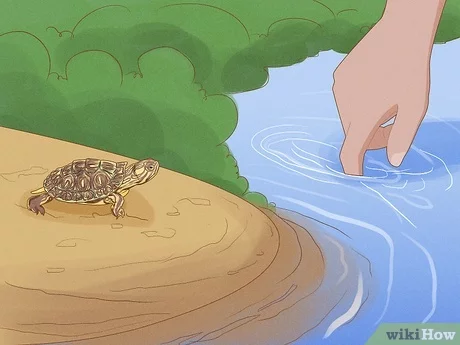### How to Catch Turtles in a Pond: A Comprehensive Guide
Turtles are fascinating creatures that inhabit various aquatic environments, including ponds. If you’re interested in observing or studying turtles up close, catching them in a pond can be an exciting activity. However, it’s important to approach this task with caution and respect for the turtles and their habitat. In this guide, we’ll explore the best methods for catching turtles in a pond while prioritizing their well-being and the preservation of the ecosystem.
#### Understanding the Turtles and Their Habitat
Before attempting to catch turtles in a pond, it’s crucial to have a basic understanding of their behavior, habits, and the environment they inhabit. Turtles are ectothermic reptiles, meaning they rely on external sources of heat to regulate their body temperature. They are also known for basking in the sun on logs or rocks near the water’s edge.
Ponds provide turtles with a source of food, shelter, and breeding grounds. Turtles are opportunistic feeders, consuming a varied diet that includes aquatic plants, insects, small fish, and even carrion. Additionally, they rely on the pond’s underwater vegetation and debris for nesting and hibernation.
#### Responsible Catching Techniques
When catching turtles in a pond, it’s essential to prioritize their safety and minimize the disruption to their natural habitat. Here are some responsible techniques for catching turtles:
1. Observation and Patience: Before attempting to catch turtles, spend time observing their behavior from a distance. This will help you understand their movements and identify potential catching opportunities.
2. Hand Capture: One of the safest methods for catching turtles is by using your hands. Slowly and gently approach the turtle from behind, avoiding sudden movements that could startle or stress the animal. Carefully grasp the turtle by its shell, ensuring a secure but gentle hold.
3. Nets and Traps: If hand capture is not feasible, consider using a turtle-friendly net or trap. Ensure that the net or trap is specifically designed for catching turtles and does not cause harm or stress to the animals.
4. Avoid Harmful Tools: Avoid using harmful tools or methods that can injure the turtles, such as sharp objects or excessive force. It’s important to prioritize the well-being of the turtles throughout the catching process.
#### Safety Precautions
While catching turtles in a pond can be an enriching experience, it’s essential to prioritize safety for both the turtles and yourself. Here are some safety precautions to keep in mind:
– Protective Gear: When handling turtles, consider wearing gloves to protect your hands from potential scratches or bites. Additionally, sturdy footwear can provide traction on slippery pond surfaces.
– Avoid Disturbing Nesting Sites: Be mindful of nesting sites and avoid disturbing them during the catching process. Disturbing nesting sites can disrupt the turtles’ reproductive cycle and have long-term implications for their population.
– Release Protocol: If catching turtles for observation or research purposes, have a clear plan for their safe release back into the pond. Minimize the duration of captivity and ensure a smooth transition back into their natural habitat.
#### Ethical Considerations
Responsible turtle catching also involves ethical considerations regarding the welfare of the turtles and the preservation of the pond ecosystem. Here are some ethical considerations to bear in mind:
– Minimal Impact: Strive to minimize the impact on the pond’s ecosystem during the catching process. Avoid damaging aquatic vegetation or disturbing other wildlife in the area.
– Respect Boundaries: Be mindful of private property and obtain necessary permissions before attempting to catch turtles in a pond. Respect any regulations or guidelines pertaining to wildlife interaction in the area.
– Educational Purposes: If catching turtles for educational or research purposes, ensure that the activities align with ethical standards and contribute to conservation efforts and scientific understanding.
#### Releasing the Turtles
After catching turtles in a pond, it’s crucial to release them back into their natural habitat promptly. Here are some guidelines for releasing the turtles:
– Gentle Handling: Handle the turtles with care and gentleness during the release process. Avoid dropping or mishandling them, as this can cause unnecessary stress and potential injuries.
– Return to Original Location: Whenever possible, release the turtles back into the same location where they were initially caught. This helps minimize disruption to their natural behavior and territory.
– Observe from a Distance: After releasing the turtles, observe them from a distance to ensure that they acclimate well to their environment. This allows you to witness their return to their natural habitat without causing further disturbance.
#### Conservation and Preservation
In addition to catching turtles for observation or research, it’s crucial to prioritize their conservation and the preservation of their pond habitat. Here are some ways to contribute to turtle conservation efforts:
– Habitat Protection: Support initiatives aimed at preserving and restoring natural habitats for turtles, including ponds, wetlands, and other aquatic environments.
– Education and Awareness: Raise awareness about the importance of turtle conservation and the role of ponds in supporting diverse wildlife. Educate others about the significance of preserving natural ecosystems.
– Community Involvement: Get involved in community-based conservation projects that focus on pr



